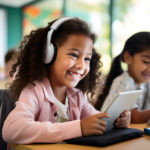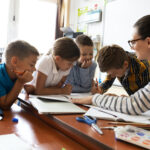Blended and hybrid learning models were first introduced to extend personalized and flexible learning options to selected individuals or groups of students. But with onset of the pandemic, widespread adoption of blended and hybrid models suddenly became a necessity across all student populations.
Two years later, how have districts overcome the initial challenges and applied the lessons learned to re-imagine teaching and learning and develop an innovative vision for change in their school communities?
Join eSchool News for a panel discussion with leaders and educators who share a passion for the bold new vision of blended and hybrid learning as the future of education.
You’ll hear how schools can:
- Integrate flexible in-person learning experiences with enhanced collaborative online learning to maximize facility use
- Build a custom curriculum with a mix of core courses, electives, CTE pathways, and more
- Deliver instruction with their teachers, virtual teachers, or a combination of the two
- Reserve the option for some students to attend 100-percent online
- 4 ways to support work-based learning - April 23, 2024
- Prioritizing inclusivity in game-based learning - April 22, 2024
- Friday 5: Universal Design for Learning - April 19, 2024
More from eSchool News
4 ways to encourage play in education
As a longtime educator, I’ve witnessed firsthand the incredible benefits that play can have in a K–8 classroom. Unstructured play is how students learn to interact with the world around them.
It’s time to pay student teachers
I fell in love with teaching while working as an assistant educator at a preschool 16 years ago. I had not studied education, so I enrolled in an alternative certification program.
The evolving requirements of a K-12 school network
As the school year began this year, the White House announced several initiatives to curb cyberattacks on K-12 schools. This was in response to a 2022-2023 school year that saw eight major cyberattacks.
A bungled FAFSA rollout threatens students’ college ambitions
Christian Rojas Linares can’t finish his financial aid forms because he’s been blanketed with error messages. The New York City high school senior has even received incorrect emails telling him his application was canceled.
4 ways to support work-based learning
As work-based learning models grow in popularity, a new report from the Center for American Progress (CAP) highlights key themes in recently-passed state legislation that will support efforts to expand or improve such models.
Prioritizing inclusivity in game-based learning
Applying the principles and practices of inclusive design in game-based learning can expand access to rich learning experiences to a neurodiverse group of learners, according to a new whitepaper from Kahoot!.
Using universal screening to improve student well-being
The pandemic shined a light on the mental health crisis facing our students–but student well-being is not a new phenomenon.
Friday 5: Universal Design for Learning
In a nutshell, Universal Design for Learning, or UDL, is a framework that urges educators, policymakers, and all education stakeholders to think about teaching and learning in a way that gives all students–regardless of ability or need–equal opportunities to reach their full potential.
3 ways to avoid summer learning loss
While it can be easy for teachers and students to slip out of routine over the summer break, it’s important that students don’t get out of the habit of learning, lest they suffer learning loss.
Educators love their edtech, but want more training
An overwhelming majority of educators believe edtech makes teaching and learning better, according to a new survey from classroom management solution NetSupport.










